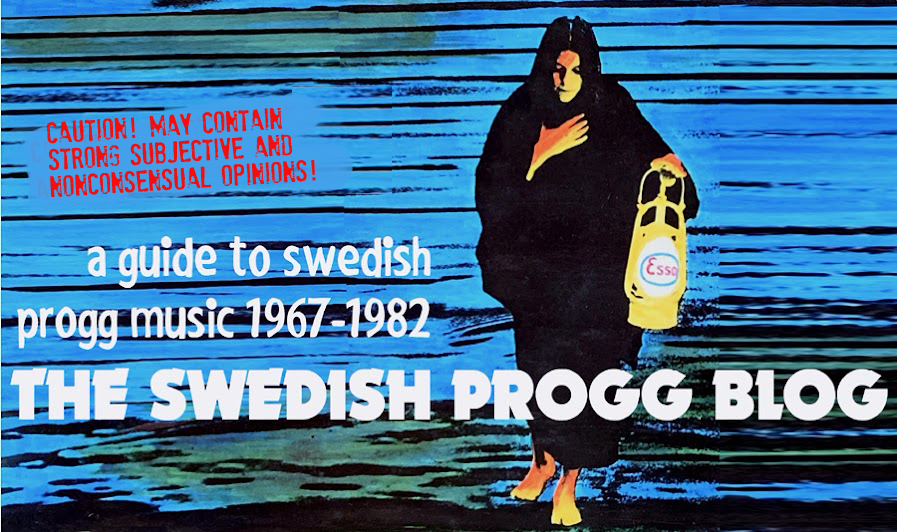Hoola Bandoola Band was the
commercially most successful progg band during the 70's, and their
popularity reached far beyond the progg circuits. They're still the
emblematic progg band to many (with fans even among those with right
wing views), while others consider them too straight in a Bob Dylan
and The Band ilk to deserve to even be called progg. What's progg and
what's not is an endless and mostly uninteresting debate. No matter
what: HBB's songwriter Mikael Wiehe was (and sometimes still is) a
talented songwriter with a knack for memorable melodies and
well-written lyrics.
The band's other front person was Björn
Afzelius. Like Wiehe, he sang, played the guitar and wrote songs.
Except that few knew of his songwriting skills at the time – Wiehe
wouldn't let up any songwriting space to Afzelius. In 1974, one year
before HBB's last album ”Fri information” hit the shops and three
years before they officially disbanded, Afzelius released his first
solo album, ”Vem är det som är rädd?” (”who's afraid?”).
Vem är det som är rädd? (MNW,
1974)
Swedish vocals
International relevance: **
It's not far-fetched to assume that
Afzelius recorded ”Vem är det som är rädd?” out of a vast
amount of frustration with his compadre Wiehe's reluctance to let the
band record any of his songs. Especially since Wiehe promised
Afzelius that his song ”Bläckfisken” would be incorporated in
HBB's recorded repertoire, telling Afzelius that ”you have written
a complete song”, failing to fulfill his promise by keeping
it off any album. ”Bläckfisken” ended up on ”Vem är det som
är rädd?” instead, making it the most important track on the
album.
While ”Bläckfisken” is the best
track on the album, there are other nice songs here. ”Historien har
visat” is a soft flowing waltz with a faint psychedelic touch
thanks to Roland Gottlow's Doors inspired organ and Ola Sandén's
hushed fuzz guitar near the end. ”Dialog i Mariagränd” reveals
Afzelius' appreciation of Dylan, and even more so does ”De tre
musketörerna from Fagersjö” which is suspiciously similar to
”It's Alright Ma (I'm Only Bleeding”, before evolving into
something not entirely unlike The Rolling Stones' ”Sympathy for the
Devil”.
”Vem är det som är rädd?” is
less polished than Afzelius' other albums. While uneven and at times
obviously derivative, it still stands as Björn Afzelius' best solo
effort.
The cover art was made by Blå Tåget's
Tore Berger.
För kung & fosterland (Nacksving,
1976)
Swedish vocals
International relevance: *
”För kung & fosterland” marked
the beginning of Afzelius' long stint with the Nacksving label, run
by Gothenburg's self-appointed progg pope Tommy Rander. Thanks to a
higher budget it's a more accomplished work than its predecessor. The
sound and performances are tighter, sporting quite a few howling guitars, very
much in the down-and-dirty rock style typical to the Gothenburg
progg. Opening track ”Du är aldrig ensam” is an effective rock
workout, and the title track is effective enough, but the mawkishness
that came to be predominant in a lot of Afzelius' later work comes
creeping in on ”Fröken Julie”. All in all his second best solo album (which doesn't say much), with one of the most dreadful album covers of the entire progg era (which says quite a lot), ironic or not.
Johnny Boy (Nacksving, 1978)
Swedish vocals
International relevance *
The first album released as Björn
Afzelius Band, and with it Afzelius' songs grew longer. Several of
the songs land around the 6-7 minutes mark, and ”Atlantis” even
stretches out to a bit over 12 minutes. The production is lavish but
can't hide the fact that Afzelius' lyrics were getting sloppier, expressing a bland, generic socialism phrased with
increasingly cheap and awkward rhymes.
Musically the album finds Afzelius sliding further down in the cheesy
abyss, with simplistic melodies framed by heavy handed rock
arrangements.
Another Tale to Tell (Nacksving,
1979)
English vocals
International relevance **
A promo album with eight songs from his previous
albums re-recorded in English. With a smaller sounding band (still
named Björn Afzelius Band) providing the songs with a rougher edge,
it's marginally better than ”Johnny Boy” and the following album ”Bakom kulisserna”, but still negligible. English pronounciation wasn't
Afzelius' strong point either. Interesting only as the curio it is.
Bakom kulisserna (Nacksving, 1980)
Swedish vocals
International relevance *
Technically released in 1980 but recorded in 1979. What made ”Johnny Boy” so bad makes ”Bakom
kulisserna” even worse. Silly rock backing, sometimes expanded with
an increasing amount parodical country. The lyrics sounds even more
rushed than before. Also, Afzelius' later trademark 'locked jaw' way
of singing through his teeth is beginning to really show here –
very irritating.
In the 80's, Afzelius' career went off
the deep end artistically, but reached the top commercially. He released many albums and
scored several hits making him a national icon. A chronic smoker,
Afzelius died from lung cancer in February 1999. In 2014 the
documentary ”Tusen bitar” (named after one of his most successful
songs) was released to critical acclaim despite being a rather
superficial and insufficient look on his life.
from Another Tale to Tell






No comments:
Post a Comment